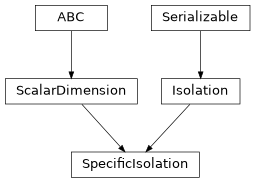Specific Isolation¶

The specific isolation implementation is a simplified isolation assumption assuming a scalar relationship between transmitted waveforms and waveforms leaking into the receiving radio-frequency chains.
Configuring a SimulatedDevice's
with a specific isolation model is achived by setting the isolation
property of an instance.
1# Create a new device
2simulation = Simulation()
3device = simulation.new_device()
4
5# Specify the device's isolation model with a high-pass characteristic
6leakage_frequency_response = np.zeros((1, 1, 101))
7leakage_frequency_response[0, 0, :50] = np.linspace(1, 0, 50, endpoint=False)
8leakage_frequency_response[0, 0, 50:] = np.linspace(0, 1, 51, endpoint=True)
9leakage_impulse_response = ifft(ifftshift(leakage_frequency_response))
10device.isolation = SelectiveLeakage(leakage_impulse_response)
- class SpecificIsolation(isolation=None, device=None)[source]¶
Bases:
ScalarDimension,IsolationSpecific leakage between RF chains.
- Parameters:
isolation (
ndarray|float|int) – Linear isolation power scales between transmit and receive chains. Defaults to None.device (
SimulatedDevice|None) – The device to which the isolation applies.
- classmethod Deserialize(process)[source]¶
Deserialize an object’s state.
Objects cannot be deserialized directly, instead a
Factorymust be instructed to carry out the deserialization process.- Parameters:
process (
DeserializationProcess) – The current stage of the deserialization process. This object is generated by theFactoryand provides an interface to deserialization methods supporting multiple backends.- Return type:
- Returns:
The deserialized object.
- serialize(serialization_process)[source]¶
Serialize this object’s state.
Objects cannot be serialized directly, instead a
Factorymust be instructed to carry out the serialization process.